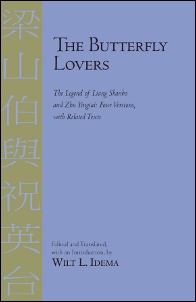|
by William Noseworthy

Wilt L. Idema, editor and translator, The Butterfly Lovers: The Legend of Liang Shanbo and Zhu Yingtai: Four Versions with Related Texts, Hackett Publishing, 2010. 215 pgs. In The Butterfly Lovers, Wilt L. Idema solidifies his name among the long list of accomplished scholars to revisit the classic story of Liang Shanbo and Zhu Yingtai. This is a narrative that has shaped the minds of billions. Drawing on a tradition transmitted from brush to pen to film, from the Tang Dynasty to the present, Idema combines more than thirty works and interpretations of the classic tale in Chinese and Japanese, six previous translations and more than twenty studies and interpretations published in Western languages. This publication not only has clear scholarly clout but is also imbued with great literary value. In the introduction, we are given a succinct portrayal of very nearly a millennia and a half of Chinese literary history. What follows next are four versions of the classic tale of divided lovers. The tale is often called the Chinese Romeo and Juliet, but this is no Sinification of the eternally opposed Montagues and Capulets. Instead the Butterfly Lovers has a long history, originating from obscure classic references to the "gown of the loyal wife" and the discourse over desire and duty. For those unfamiliar with the story, its basic outline goes something like this. As a young intellectual, the female Zhu Yingtai dons masculine garb to portray herself as a scholar. She then proceeds to spend three years studying at university becoming a master of the classics, simultaneously falling for her near second, Liang Shanbo. The two quickly become immersed in each other's verse and prose. Soon, however, Liang begins to notice Zhu's odd behavior. Though she goes through substantial efforts to evade the suspicions of Liang and others (in one version of the story this subplot influences a revolutionary change to educational hygiene with the introduction of the bathroom pass system), she eventually resigns her efforts out of a fear of being discovered. Before she leaves she tells Liang to pursue her, in the guise of his asking for her sister's hand in marriage. When she returns home, she finds herself betrothed to a man from the local Ma family. Despite this arrangement, she cannot hide her desire for Liang upon his arrival and certainly not after his discovery of her true identity. When he discovers Zhu's marital commitments, Liang naturally dies of a broken heart, though not before composing an almost voluminous amount of material dedicated to her. The story generally ends with a dramatic climax as Zhu is making her way to marry Ma. In one version of the story, we are told she "left the boat and wept for him. The earth then suddenly split asunder and swallowed her. This was the way she was buried together with him." In the more poetic versions as she falls into his grave (not always from a boat), her servants desperately grasp at her clothes, shredding them as they transform with her love into a swarm of butterflies. The complexity of Idema's interpretations of these texts lies neither with their meaning as individual pieces nor with their scholarly merit, rather it is with the variance of their intended audience. Drawn together, the four translated versions that Idema has offered differ greatly. The Ballad of Liang Shabo and Zhu Yingtai's Common Study as Sworn Brothers moves effortlessly between prose and verse, with the former acting almost as exegetical commentary. The Song of Liang Shanbo, valued for its representation of classic form, takes great strides to adhere to traditional meter and composition. For contemporary readers who prefer to be free of the bounds of classic verse, Yingtai's Grief is considerably more fluid. Finally, for readers interested in the social setting, A Daoqing: Liang Shanbo and Zhu Yingtai offers itself as a text of the operettas popular in the Yellow River Delta since the days of the Tang. Both the introduction and the appendices to this text offer an astounding cultural supplement to the work. From the analysis of the Maps and Facts of Siming in the Qiandao Period (Qiandao Siming tujing) by Zhang Jin (1130-1180), which recorded the location of the grave of Liang and Zhu (ten li to the west of the county capital behind the Court of Reception), we learn that there was a temple from the Ten Circuits (Yizhongwang miao) dedicated to the lovers that has been maintained till the 20th century. We are also reminded that the 20th century cultural context added new interpretations of the Butterfly Lovers with the narrative's first cinenamatic appearance in 1926, and a second time in 1954, before being remade into the classic The Love Eterne (1963), a film that inspired Ang Lee to begin his career in cinema. In the end, Idema's contribution reminds us that the tale of Liang and Zhu is much more than a Chinese version of Romeo and Juliet—it is a canonical text of world literature. |